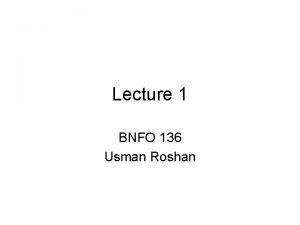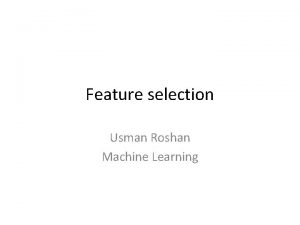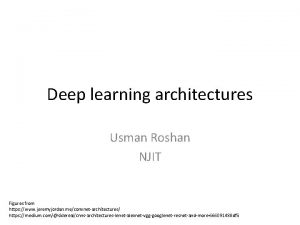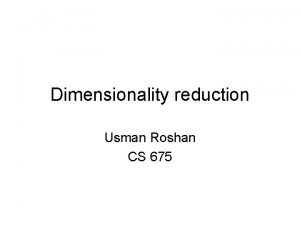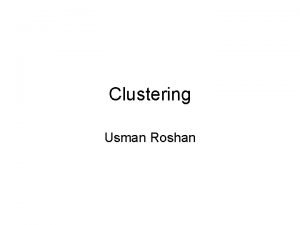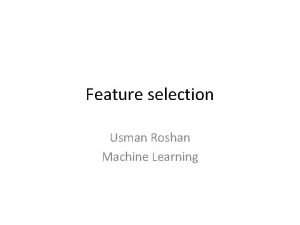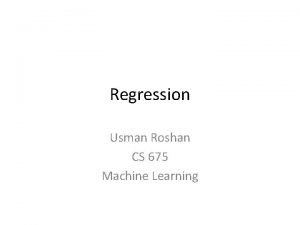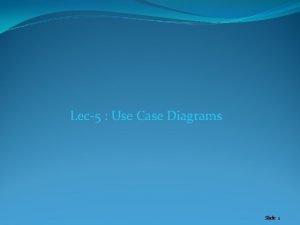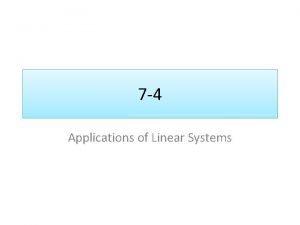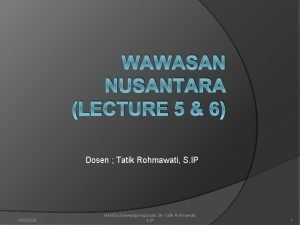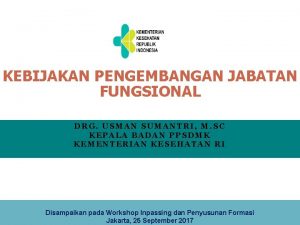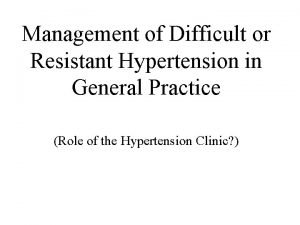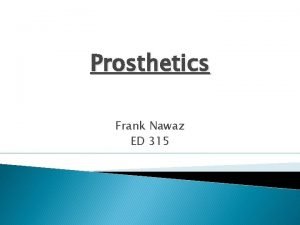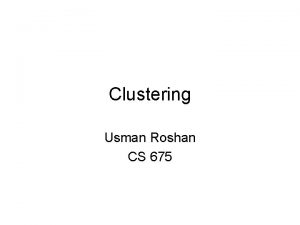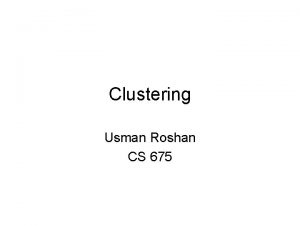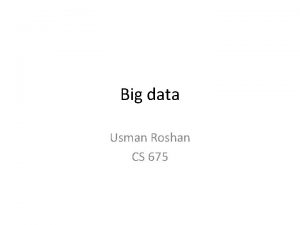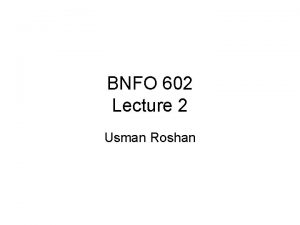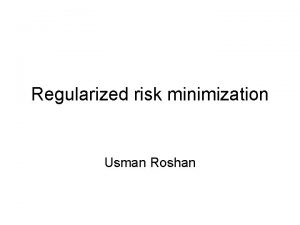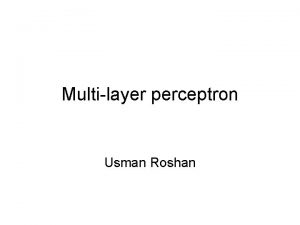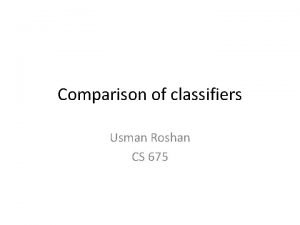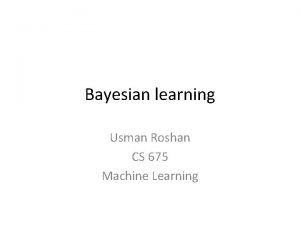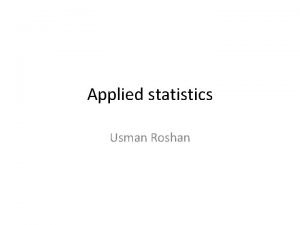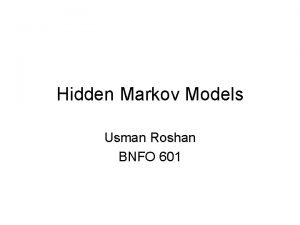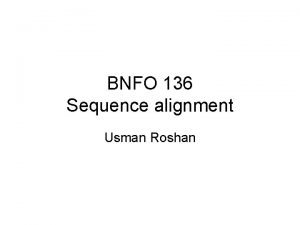Clustering Usman Roshan Clustering Suppose we want to

























- Slides: 25

Clustering Usman Roshan

Clustering • Suppose we want to cluster n vectors in Rd into two groups. Define C 1 and C 2 as the two groups. • Our objective is to find C 1 and C 2 that minimize where mi is the mean of class Ci

Clustering • NP hard even for 2 -means • NP hard even on plane • K-means heuristic – Popular and hard to beat – Introduced in 1950 s and 1960 s

K-means algorithm for two clusters Input: Algorithm: 1. Initialize: assign xi to C 1 or C 2 with equal probability and compute means: 2. Recompute clusters: assign xi to C 1 if ||xi-m 1||<||xi-m 2||, otherwise assign to C 2 Recompute means m 1 and m 2 Compute objective 3. 4. 5. Compute objective of new clustering. If difference is smaller than then stop, otherwise go to step 2.

K-means • Is it guaranteed to find the clustering which optimizes the objective? • It is guaranteed to find a local optimal • We can prove that the objective decreases with subsequence iterations

Proof sketch of convergence of k-means Justification of first inequality: by assigning xj to the closest mean the objective decreases or stays the same Justification of second inequality: for a given cluster its mean minimizes squared error loss

K-means clustering • K-means is the Expected-Maximization solution if we assume data is generated by Gaussian distribution – EM: Find clustering of data that maximizes likelihood – Unsupervised means no parameters given. Thus we iterate between estimating expected and actual values of parameters • PCA gives relaxed solution to k-means clustering. Sketch of proof: – Cast k-means clustering as maximization problem – Relax cluster indicator variables to be continuous and solution is given by PCA

K-means clustering • K-medians variant: – Select cluster center that is the median – Has the effect of minimizing L 1 error • K-medoid – Cluster center is an actual datapoint (not same as k-medians) • Algorithms similar to k-means • Similar local minima problems to kmeans

Other clustering algorithms • Spherical k-means – Normalize each datapoint (set length to 1) – Clustering by finding center with minimum cosine angle to cluster points – Similar iterative algorithm to Euclidean kmeans – Converges with similar proofs.

Other clustering algorithms • Hierarchical clustering – Initialize n clusters where each datapoint is in its own cluster – Merge two nearest clusters into one – Update distances of new cluster to existing ones – Repeat step 2 until k clusters are formed.

Graph clustering • Graph Laplacians widely used in spectral clustering (see tutorial on course website) • Weights Cij may be obtained via – Epsilon neighborhood graph – K-nearest neighbor graph – Fully connected graph • Allows semi-supervised analysis (where test data is available but not labels)

Graph clustering • We can cluster data using the mincut problem • Balanced version is NP-hard • We can rewrite balanced mincut problem with graph Laplacians. Still NPhard because solution is allowed only discrete values • By relaxing to allow real values we obtain spectral clustering.

Graph Laplacians • We can perform clustering with the Laplacian L = D – C where Dii = Σj. Cij • Basic algorithm for k clusters: – Compute first k eigenvectors vi of Laplacian matrix – Let V = [v 1, v 2, …, vk] – Cluster rows of V (using k-means)

Graph clustering • Why does it work? • Relaxation of NP-hard clustering • What is relaxation: changing the hard objective into an easier one that will yield real (as oppose to discrete) solutions and be at most the true objective • Can a relaxed solution give optimal discrete solution? No guarantees

Graph clustering • Cut problems are NP-hard. • We obtain relaxed solutions via eigenvectors of original weight matrix and its Laplacian. From Shi and Malik, IEEE Pattern Analysis and Machine Intelligence, 2000

Graph Laplacians and cuts • Recall from earlier the WMV dimensionality reduction criterion • WMV is also given by where X = [x 1, x 2, …, xn] contains each xi as a column and L is the graph Laplacian. • Thus

Graph Laplacians and cuts • For a graph with arbitrary edge weights if we define input vectors x in a certain way then the WMV criterion gives us the ratio cut. • For proof see page 9 of tutorial (also give in next slide)

Graph Laplacians and cuts From Spectral clustering tutorial by Ulrike von Luxborg

Graph Laplacians and cuts From Spectral clustering tutorial by Ulrike von Luxborg

Application on population structure data • Data are vectors xi where each feature takes on values 0, 1, and 2 to denote number of alleles of a particular single nucleotide polymorphism (SNP) • Output yi is an integer indicating the population group a vector belongs to

Publicly available real data • Datasets (Noah Rosenberg’s lab): – East Asian admixture: 10 individuals from Cambodia, 15 from Siberia, 49 from China, and 16 from Japan; 459, 188 SNPs – African admixture: 32 Biaka Pygmy individuals, 15 Mbuti Pygmy, 24 Mandenka, 25 Yoruba, 7 San from Namibia, 8 Bantu of South Africa, and 12 Bantu of Kenya; 454, 732 SNPs – Middle Eastern admixture: contains 43 Druze from Israil. Carmel, 47 Bedouins from Israel-Negev, 26 Palestinians from Israel-Central, and 30 Mozabite from Algeria-Mzab; 438, 596 SNPs

East Asian populations

African populations

Middle Eastern populations

K-means applied to PCA data • PCA and kernel PCA (poly degree 2) • K-means and spherical k-means • Number of clusters set to true value
 Usman roshan
Usman roshan Usman roshan
Usman roshan Usman roshan
Usman roshan Njit machine learning
Njit machine learning Usman roshan
Usman roshan Luxborg
Luxborg Usman roshan
Usman roshan Cs 675 njit
Cs 675 njit Nyt top stories
Nyt top stories Partitional clustering vs hierarchical clustering
Partitional clustering vs hierarchical clustering Euclidean distance rumus
Euclidean distance rumus Suppose we want to develop software for an alarm clock
Suppose we want to develop software for an alarm clock Suppose you want to combine two types of fruit drink
Suppose you want to combine two types of fruit drink Roshan dalvi
Roshan dalvi Roshan chitrakar
Roshan chitrakar Roshan dalvi
Roshan dalvi Rohana roshan
Rohana roshan Pengertian wawasan nusantara menurut prof wan usman
Pengertian wawasan nusantara menurut prof wan usman Nabila usman
Nabila usman Dr kauser usman
Dr kauser usman Dr kauser usman
Dr kauser usman Dr kauser usman clinic address
Dr kauser usman clinic address Usman mahboob
Usman mahboob Drg usman sumantri
Drg usman sumantri Dr kauser usman clinic address
Dr kauser usman clinic address Usman nawaz missing
Usman nawaz missing

